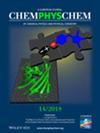半胱氨酸钝化金属卤化物钙钛矿纳米团簇中固有手性的来源。
IF 2.3
3区 化学
Q3 CHEMISTRY, PHYSICAL
引用次数: 0
摘要
利用L-半胱氨酸或L-半胱氨酸合成了配体辅助钙钛矿纳米团簇(pnc),并对其在430 nm左右的紫外可见光谱特征进行了验证。圆二色性(CD)光谱在430 ~ 440 nm范围内显示出明显的手性,揭示了pnc的手性。有趣的是,CD信号的符号总是负的,与L-或d -胱氨酸的手性无关。这条430-440 nm的CD波段初步归因于合成过程中使用的溶剂和反溶剂的不对称液-液界面导致两个对映体比例不均匀的pnc内形成了新的手性立体中心。本文章由计算机程序翻译,如有差异,请以英文原文为准。
Origin of Intrinsic Chirality in Cysteine-Passivated Metal Halide Perovskite Nanoclusters.
Ligand-assisted perovskite nanoclusters (PNCs) have been synthesized using oleylamine and L- or D-cysteine as confirmed based on their characteristic electronic absorption bands around 430 nm based on ultraviolet-visible spectra. Circular dichroism (CD) spectra show distinct chiroptical bands in the 430-440 nm region, revealing the chirality of the PNCs. Interestingly, the sign of the CD signal is always negative, independent of the chirality for L- or D-cystine. This 430-440 nm CD band is tentatively attributed to the formation of new chiral stereocenters within the PNCs with an uneven ratio of two enantiomers induced by the asymmetric liquid-liquid interface from the solvent and antisolvent used during synthesis.
求助全文
通过发布文献求助,成功后即可免费获取论文全文。
去求助
来源期刊

Chemphyschem
化学-物理:原子、分子和化学物理
CiteScore
4.60
自引率
3.40%
发文量
425
审稿时长
1.1 months
期刊介绍:
ChemPhysChem is one of the leading chemistry/physics interdisciplinary journals (ISI Impact Factor 2018: 3.077) for physical chemistry and chemical physics. It is published on behalf of Chemistry Europe, an association of 16 European chemical societies.
ChemPhysChem is an international source for important primary and critical secondary information across the whole field of physical chemistry and chemical physics. It integrates this wide and flourishing field ranging from Solid State and Soft-Matter Research, Electro- and Photochemistry, Femtochemistry and Nanotechnology, Complex Systems, Single-Molecule Research, Clusters and Colloids, Catalysis and Surface Science, Biophysics and Physical Biochemistry, Atmospheric and Environmental Chemistry, and many more topics. ChemPhysChem is peer-reviewed.
 求助内容:
求助内容: 应助结果提醒方式:
应助结果提醒方式:


